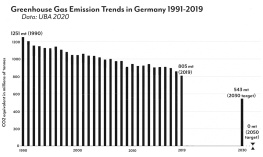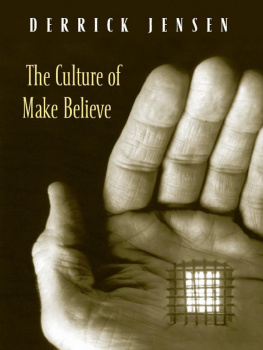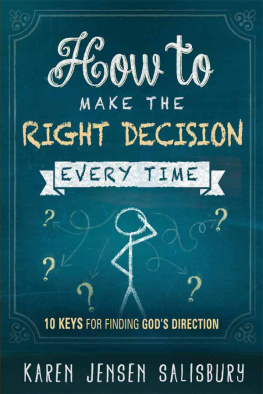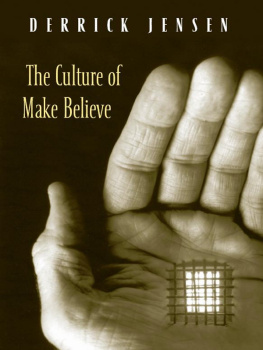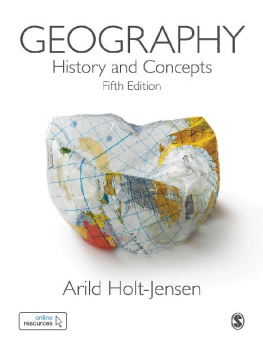

Copyright 1999 by Rolf Jensen. All rights reserved. Except as permitted under the United States Copyright Act of 1976, no part of this publication may be reproduced or distributed in any form or by any means, or stored in a database or retrieval system, without the prior written permission of the publisher.
ISBN: 978-0-07-161085-8
MHID: 0-07-161085-5
The material in this eBook also appears in the print version of this title: ISBN: 978-0-07-137968-7, MHID: 0-07-137968-1.
All trademarks are trademarks of their respective owners. Rather than put a trademark symbol after every occurrence of a trademarked name, we use names in an editorial fashion only, and to the benefit of the trademark owner, with no intention of infringement of the trademark. Where such designations appear in this book, they have been printed with initial caps.
McGraw-Hill Education eBooks are available at special quantity discounts to use as premiums and sales promotions, or for use in corporate training programs. To contact a representative please e-mail us at bulksales@mcgraw-hill.com.
TERMS OF USE
This is a copyrighted work and McGraw-Hill Education and its licensors reserve all rights in and to the work. Use of this work is subject to these terms. Except as permitted under the Copyright Act of 1976 and the right to store and retrieve one copy of the work, you may not decompile, disassemble, reverse engineer, reproduce, modify, create derivative works based upon, transmit, distribute, disseminate, sell, publish or sublicense the work or any part of it without McGraw-Hill Educations prior consent. You may use the work for your own noncommercial and personal use; any other use of the work is strictly prohibited. Your right to use the work may be terminated if you fail to comply with these terms.
THE WORK IS PROVIDED AS IS. McGRAW-HILL EDUCATION AND ITS LICENSORS MAKE NO GUARANTEES OR WARRANTIES AS TO THE ACCURACY, ADEQUACY OR COMPLETENESS OF OR RESULTS TO BE OBTAINED FROM USING THE WORK, INCLUDING ANY INFORMATION THAT CAN BE ACCESSED THROUGH THE WORK VIA HYPERLINK OR OTHERWISE, AND EXPRESSLY DISCLAIM ANY WARRANTY, EXPRESS OR IMPLIED, INCLUDING BUT NOT LIMITED TO IMPLIED WARRANTIES OF MERCHANTABILITY OR FITNESS FOR A PARTICULAR PURPOSE. McGraw-Hill Education and its licensors do not warrant or guarantee that the functions contained in the work will meet your requirements or that its operation will be uninterrupted or error free. Neither McGraw-Hill Education nor its licensors shall be liable to you or anyone else for any inaccuracy, error or omission, regardless of cause, in the work or for any damages resulting therefrom. McGraw-Hill Education has no responsibility for the content of any information accessed through the work. Under no circumstances shall McGraw-Hill Education and/or its licensors be liable for any indirect, incidental, special, punitive, consequential or similar damages that result from the use of or inability to use the work, even if any of them has been advised of the possibility of such damages. This limitation of liability shall apply to any claim or cause whatsoever whether such claim or cause arises in contract, tort or otherwise.
Contents
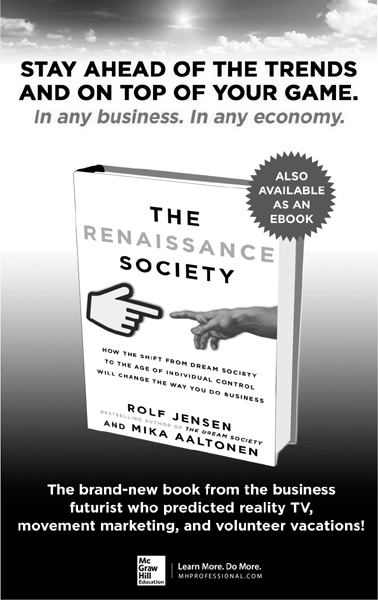
Introduction
Since The Dream Society was published, we have entered a new century. It has given us wars, periods of high growth, and a prolonged recession. The most important trend for the long term, however, is that a new global world order is taking shape. Does The Dream Society still have a relevant message for us? My answer is yes, and this message is even more relevant today. Let me illustrate it with a small but true story.
A friend of mine, his wife, and his teenage daughter were enjoying a vacation in a cottage. After a few days, his daughter said, Lets go to the town and visit the stores. My friend replied, What do you need? His daughter said, How would I know when I havent been there! To my old friend, shopping was about real needs, like buying a coat when it is cold. To his daughter, shopping was a lifestyleit was for inspiration, for fun, for buying into another lifestyle or another persona. The old world met the new one.
This is what The Dream Society is about.
Most books about the future of business and society are about the short term. The Dream Society is not. Its idea is based on a long-term trend: because of economic growth, the consumer can afford to buy with her heart. Function is taken for granted; it becomes a by-product. What we pay for is the style and its contribution to our self-portrait. It is not about the T-shirt; it is what is written on it that counts and that determines its price. Your electronics become a lifestyle statement, as do your coffee and your clothes. Your stuff becomes a story that says, This is who I am.
This is a long-term trend indeed. During 99.9 percent of the history of Homo sapiens, we have been extremely poor. Luxury was only for kings and aristocrats; they could afford more than the necessities of life, and they could flash their wealth and lifestyle. We are watching a great shift: from having not enough or at best enough to having more than enough for the vast majority of the population in the mature economies. This more than enough is spent on products and services that offer more than functionthat have design, a story, and a heart. We have all become kings, queens, and aristocrats.
In the old world, work was something that you needed to do in order to feed your family. The best would be if you could live without working at the assembly line. In the new world, while work is still about the money we earn, it is now not only about thatwork has become more social, more engaging, and more challenging. It is a part of our lives, not just an unavoidable evil. The Dream Society is about this societal transformation, too.
Is this long-term trend irreversible? I think so. A recession may delay it a bit, but as soon as growth returns (and it always does), we likewise return to the trend.
I have been accused of being an optimist, and this is not merely an accusation, but a fact.
I do not apologize. In the art of peeking into the future, we cannot avoid emotions. Studies of the future are not science in the same way that physics isthere is room for different views. To me, the future is a fascinating subject, and it is the most relevant one, since this is where we shall spend the rest of our lives. We all need ideas about the future; we cannot accept that the years ahead of us are just a black box, an empty space, or a big unknown.
One trend in the study of the future is the optimistic one, like The Dream Society; the other is the pessimistic one. The pessimistic studies claim that in the future, we may not have enough food for a growing world population, we may not have enough raw materials, and we may not act in time to create a more sustainable globe and stop climate change. We may fear wars, terrorism, and crime. We may even fear epidemics and social unrest. Last, but not least, will economic growth in the mature economies return? Up to a certain point, we can try to disprove these fears with statistics, but basically, the fundamental issue is a matter of belief about how to meet the future.
I think we should meet the future as a good friend, a friend that we would like to know better. If we meet the future as an enemy that is a threat to us, then we are forgetting our history. There have always been challenges facing usand actually, some of them have been bigger than those we face at present. We must believe in our ability to deal with the current challenges just as we have done in the past. A society without a positive attitude toward the futureone that does not believe that the challenges can be met and the problems can be solvedis not a healthy society. The future must not be seen as an enemy.
Next page




